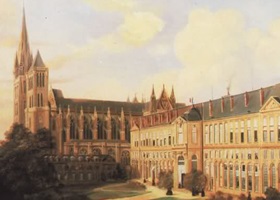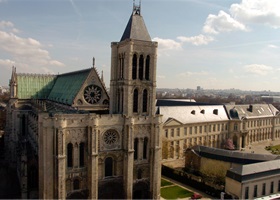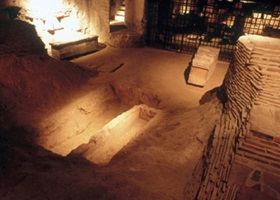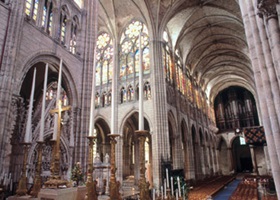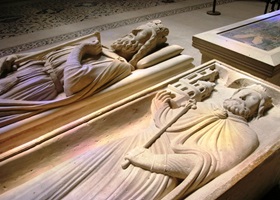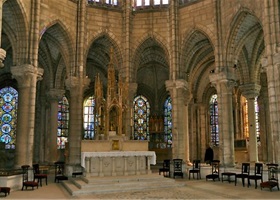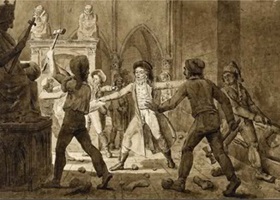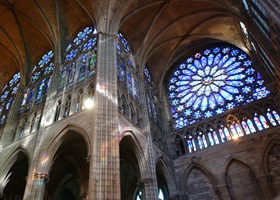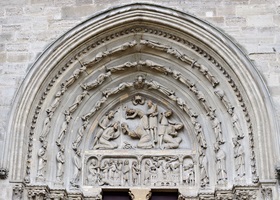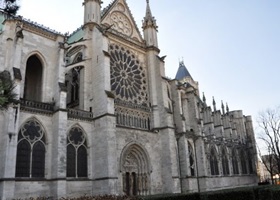The Basilique Saint-Denis
The story of the Basilique Saint-Denis dates back to the 5th century (475) when Saint Geneviève had a church built on the presumed tumb of Saint Denis, first bishop of Paris, beheaded in 280.
In the 7th century, Dagobert Ist, king of Francs, had a huge abbey built and was the first king to be inhumed there. The church then became the necropolis of most kings of France.
In the 8th century, around 750, Pépin le Bref (714-768) rebuilt the Carolingian basilica and had works done on the royal necropolis.
In 754, the pope crowned Pépin le Bref in the Basilique Saint-Denis, in presence of his son Charlemagne.
In 775, Charlemagne was there for the consecration of the new basilic and its Carolingian crypt.
In the middle of the 9th century, Vikings invaded Paris and looted the basilica. The monastery was fortified to resist potential attacks.
In the 12th century, abbey Suger was one the main churchmen to take care of the abbey of Saint-Denis. Starting in 1135, he took it upon himself to rebuild the old Carolingian building.
This important architectural renovation was inspired by a series of technical experiments in Europe. It’s also linked to a theological conception of light, inspired by mystical texts of Pseudo-Denys, which was the base of many teachings of the time.
The absence of walls between the chapels and the fact that the stained glass surface doubled in the prayers’ rooms, create a changing wall of light. With this innovative architectural vision, Suger started the gothic art movement in the Île-de-France, which Italien detractors would despise.
Being the first Gothic-style building, the Basilique Saint-Denis later served as a model for works of art such as Notre-Dame de Chartres, and Notre-Dame de Paris.
In 1140, abbey Suger built a new chevet, more luminous and spacious, more suited to the many pilgrims, who came to visit. It is composed of monolithic columns and full of light. It was sacred in 1144, in presence of king Louis VII (1120-1180).
In the 13th century, Saint Louis (Louis IX, 1214-1270), financially took part in the reconstruction of the abbey, major work of art of the 13th century. The works started in 1231, under the direction of Pierre de Montreuil, master of works of Notre-Dame de Paris, among others.
The works lasted less than fifty years and ended in 1281, which goes to show the richness of the abbey.
28-meters high under the vaults, it actually looks much higher and impressive thanks to the pillars. They’re composed of several thin columns, which correspond to the ribs of the different arches of the vaults. The gothic architecture, which was then called “French art”, reaches its peak at this century.
The monastery library, which was at the end of the Middle Ages the largest of the French kingdom, took in cultural gems. Monk Primat translated for the first time in French a large amount of texts, which was part of a larger desire to build France, as Saint Louis wanted.
Between the 17th and the 19th century, the basilica underwent a lot of damages. The first time was during the Fronde, then during the French revolution, and finally by thunder lighting, which struck the spire of the northern tower, which culminated at 86 meters. This incident happened in 1836 and the spire is still missing.
At the beginning of the 19th century, Napoléon I ordered the restoration of the building. Then Louis XVIII gave back to the abbey its necropolis status. In 1846, the end of the restoration was given to Viollet-le-Duc, who re-designed the basilica and gave it its modern look.
What you shouldn’t miss:
The stained glass: only five canopies remain from the 12th century church. Taking care of the stained glass would have cost more money than building the stone building.
The crypt: it is a testimony of the oldest history of the basilica. The old royal necropolis hides Dagobert’s gorgeous tumb.
Suger’s chevet: see description above.
The treasure: partly reconstituted, it holds liturgical items and royal crowns. The most beautiful pieces are exhibited at the Louvre museum and the National Gallery of Art in Washington.
The recumbent effigies: 70 of them are exposed in the basilica, among them Clovis and Childebert’s.
Open: all year long.
April 1st – September 30th: 10am-6.15pm (Sun: noon-6.15pm),
Oct 1st – Mar 31st: 10am – 5.15pm (Sun: noon-5.15pm).
Closed: Jan 1st, May 1st, and Dec 25th.
Rates:
Rates: full rate: 7,50€,
Reduced rate: 4,50€ (18-25 yo, non EU citizens),
Free: minors (family groups, not school groups), 18-25 yo (EU citizens), handicapped and unemployed people.
Information: Every year in June, the Festival of Saint-Denis features the greatest musical classics by Mozart, Verdi, Mahler, and Puccini…
How to get there: 1 rue de la Légion d’Honneur, 93200 St-Denis.
Métro 13 and Tram T1 Station "Basilique de Saint-Denis".
Bus lines: 153, 239 and 253.








